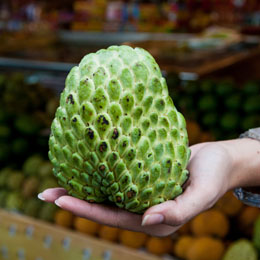Often disliked for its appearance, the custard apple is both a tree and a fruit with myriad uses. Read this Buzzle article to know more.

The custard apple is also known as anon, sugar apple, and sweetsop. The fruit has a scaly appearance and very soft pulp inside, that holds together many seeds. This tree is found in almost every tropical, sub-tropical, and monsoon region across the world.
The fruit and the plant are named as 'custard apple', due to the fact that the internal flesh of the fruit resembles a custard. It can grow to a diameter of about 3 to 6 inches and has a heart like shape, changing from green to yellow as it begins to ripe. On an average, there are about 50 to 76 seeds in one fruit. The fruit is a very rich source of food nutrition, such as sugar, calcium, carbohydrates, and fiber.
Interesting Facts
The tree belongs to the
Annonaceae family, which consists of about 2000 other members that are similar to the fruit. The average height ranges from 15 to 35 feet. The trunk is erect, can grow as big as 10 to 14 inches in diameter, and has a round spreading crown.
The leaves emit a pungent smell and are arranged in an alternating structure with an oblong, lance shape. They can grow to a size of about 4 to 8 inches. This tree follows a deciduous shedding pattern. Leaves start falling off by end of August and reappear at beginning of spring. Flowers also appear during the same time and fruits can be relished in late spring and early summer. The exact shedding and fruiting patterns differ for almost every region with fruit taking about 20 to 25 weeks to ripen. In regions like West Indies and the Indian sub-continent, the medicinal benefits of the custard apple have made it a culturally important plant.
Planters growing custard apples prefer to plant it in low-lying, rich and well draining soil. If you are living in a tropical or sub-tropical region, then you should certainly plant this tree in your garden.






 The custard apple is also known as anon, sugar apple, and sweetsop. The fruit has a scaly appearance and very soft pulp inside, that holds together many seeds. This tree is found in almost every tropical, sub-tropical, and monsoon region across the world.
The custard apple is also known as anon, sugar apple, and sweetsop. The fruit has a scaly appearance and very soft pulp inside, that holds together many seeds. This tree is found in almost every tropical, sub-tropical, and monsoon region across the world.